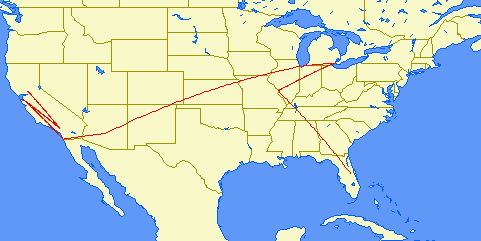Nick
Well-Known Member
I was walking through an airport terminal today and found a sheet of paper on the ground that gave today's schedule for one particular airplane. I thought some might find it interesting to see just how much the thing flies in a day and I don't doubt that this is a typical day for one of theirs, or any other airline's plane for that matter. It is just funny to see a SWA plane because it does so many legs in a day compared to a 757 or A-320 that might cover the same ground in one or two legs. The number in the parentheses is minutes on the ground between flights.
If you were N774SW today, you'd have flown:
MCO-STL 0710-0845 (25)
STL-DTW 0910-1135 (25)
DTW-MDW 1200-1225 (35)
MDW-PHX 1300-1600 (35)
PHX-SAN 1635-1640 (30)
SAN-OAK 1710-1845 (35)
OAK-ONT 1920-2035 (20)
ONT-SMF 2055-2210

Similar to this, I always find it incredible to think how little time a long haul jet can spend on the ground for days at a time, flying 10-16 hours only to sit for 90 minutes and turn around and do it again, and take a three hour break, and do another 12 hour flight, turn around, 14 hours, etc . . .
If you were N774SW today, you'd have flown:
MCO-STL 0710-0845 (25)
STL-DTW 0910-1135 (25)
DTW-MDW 1200-1225 (35)
MDW-PHX 1300-1600 (35)
PHX-SAN 1635-1640 (30)
SAN-OAK 1710-1845 (35)
OAK-ONT 1920-2035 (20)
ONT-SMF 2055-2210
Similar to this, I always find it incredible to think how little time a long haul jet can spend on the ground for days at a time, flying 10-16 hours only to sit for 90 minutes and turn around and do it again, and take a three hour break, and do another 12 hour flight, turn around, 14 hours, etc . . .
